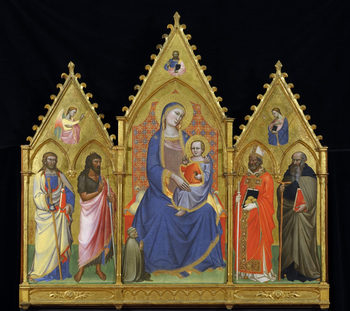The evolution of the altarpiece until the Renaissance
The origins of Christian places of worship were not buildings dedicated exclusively to prayer, but a chamber within a building, such as a room or a small corner, intended for that purpose. Here, one or two people could pray without being part of a congregation. From its origin in the Middle Ages to its heyday in the 17th century, when the altarpieces became authentic magnum opuses, they went through various mutations, among them and one of the most interesting without a doubt, were the changes that came with the Renaissance .
The altarpiece was originally a small, portable element that was normally placed on an altar table to celebrate the liturgy. Over time it evolved and also became an object with a decorative and didactic purpose. We can say that the birth of the altarpiece as such is to be found in the medieval tables that originally adorned the fronts of the altar tables, but that at a given moment are placed suspended behind it. It will be, especially in the Gothic, when these compositions that in principle were, fundamentally, paintings on panel, are going to be complicated and expanded. Thus, different ways of understanding the altarpiece will emerge: from the simplest triptychs that are developed basically in the Flemish sphere, to the complex Hispanic altarpieces that fill the entire surface of the apse or the main chapel. Initially, the structure of the altarpiece was independent, the rear part was free, visible, as a simple architectural plot that served more as a frame for the paintings, but as time progresses, the altarpieces will become true portable structures of great technical complexity. and artistic.
During the Renaissance, altarpieces began to develop and become true masterpieces. They could vary in the complexity of their construction: from the simplest dosales to the large polyptychs, divided into several sections, which displayed the artistic skills of painters such as Niccolò di Pietro Gerini, at the end of the 14th century, or the master of the school from Umbria Luca Signorelli, during the second half of the 15th century.
They underwent a great formal change from the beginning of the 15th century, when they went from being a polyptych, in a Gothic frame, to a single rectangular panel, framed in the characteristic architectural style of the church. Examples from the period show how structural change resulted in artistic and technical change.
The decoration of each work reflects where they were created and the circumstances of their origin. Behind each piece are mundane stories: commissions from the chaplains themselves, religious congregations, or private clients (known as donors) about which saints should appear, which scenes were chosen, and why.

The 16th century altarpiece that Setdart is putting out to tender on June 14 is a magnificent example of the Renaissance style in Spain. Structured in two bodies, the lower area has a classicist inspiration that refers to models from ancient times in Spain. The alternation between the frontals and the avenerated niches is inspired by the parascenium or frontals of the scenes of the Roman theaters, serve as an example that of Mérida. The upper area, which is divided into three streets, shows a more idiosyncratic style, where characteristics that come from classical antiquity alternate with elements unique to Spanish culture, thus showing an aesthetic that can be defined as plateresque. This style was characterized by combining aesthetic influences that came from the Gothic, Renaissance and Islamic repertoire. The presence of the chamfered domes, located on the sides, the pointed finial at the end of the central area and the presence of puttis, among other classical ornamentation, testify to this confluence of unique aesthetics that was the Plateresque style.
In the central area of the altarpiece, as a vanishing point and epicenter of the architectural structure, the figure of Christ can be seen, presented as an allegory of the Eucharist. From his side, a dramatic stream of blood emanates, which flows into a golden chalice, thus symbolizing the words that Christ pronounced at the last supper “Take and drink all of you, for this is my blood, blood of the new and eternal covenant , which will be poured out for you and for many, for the forgiveness of sins.”





